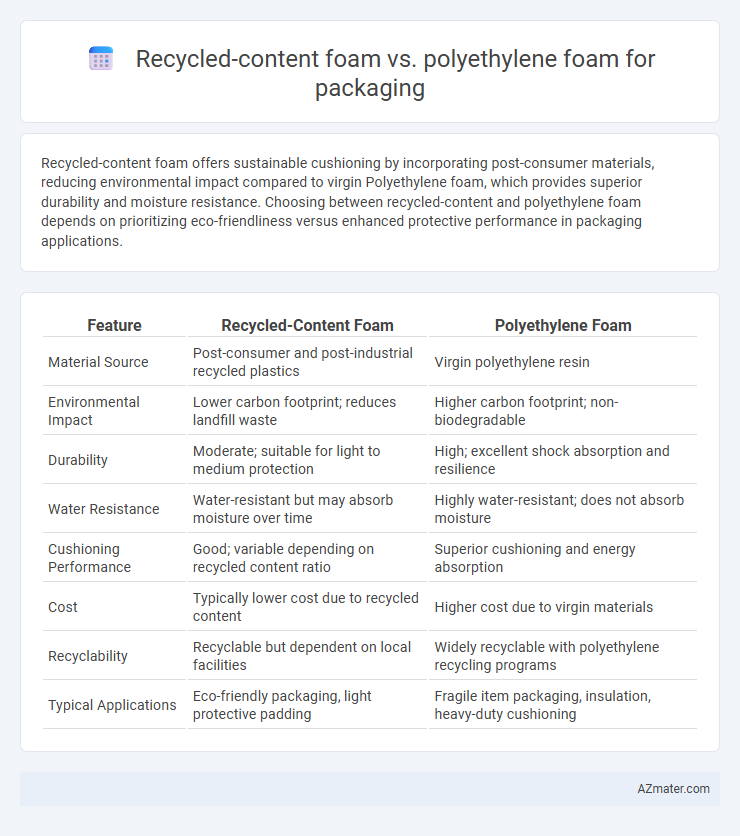Recycled-content foam offers sustainable cushioning by incorporating post-consumer materials, reducing environmental impact compared to virgin Polyethylene foam, which provides superior durability and moisture resistance. Choosing between recycled-content and polyethylene foam depends on prioritizing eco-friendliness versus enhanced protective performance in packaging applications.
Table of Comparison
| Feature | Recycled-Content Foam | Polyethylene Foam |
|---|---|---|
| Material Source | Post-consumer and post-industrial recycled plastics | Virgin polyethylene resin |
| Environmental Impact | Lower carbon footprint; reduces landfill waste | Higher carbon footprint; non-biodegradable |
| Durability | Moderate; suitable for light to medium protection | High; excellent shock absorption and resilience |
| Water Resistance | Water-resistant but may absorb moisture over time | Highly water-resistant; does not absorb moisture |
| Cushioning Performance | Good; variable depending on recycled content ratio | Superior cushioning and energy absorption |
| Cost | Typically lower cost due to recycled content | Higher cost due to virgin materials |
| Recyclability | Recyclable but dependent on local facilities | Widely recyclable with polyethylene recycling programs |
| Typical Applications | Eco-friendly packaging, light protective padding | Fragile item packaging, insulation, heavy-duty cushioning |
Introduction to Packaging Foams
Recycled-content foam and polyethylene foam serve distinct roles in packaging due to their material properties and environmental impacts. Recycled-content foam emphasizes sustainability by incorporating post-consumer or industrial waste, reducing landfill contributions and conserving resources. Polyethylene foam offers superior cushioning and impact resistance, making it ideal for protecting delicate items during shipping and storage within various industries.
What is Recycled-content Foam?
Recycled-content foam is a sustainable packaging material made by incorporating post-consumer or post-industrial recycled plastics into the foam production process, reducing environmental impact and landfill waste. This foam maintains cushioning and protective properties similar to virgin polyethylene foam but with a lower carbon footprint. Its use supports circular economy initiatives by diverting plastics from waste streams while providing durable, lightweight packaging solutions.
Overview of Polyethylene Foam
Polyethylene foam is a versatile, lightweight, closed-cell material widely used in packaging for its excellent shock absorption and moisture resistance. Its durable structure provides superior cushioning protection for delicate items during shipping and handling. Compared to recycled-content foam, polyethylene foam offers consistent performance, chemical inertness, and enhanced thermal insulation properties.
Environmental Impact Comparison
Recycled-content foam significantly reduces environmental impact by lowering landfill waste and conserving raw materials compared to traditional polyethylene foam, which relies heavily on virgin petroleum resources. The production of recycled-content foam typically generates fewer greenhouse gas emissions and consumes less energy, contributing to a smaller carbon footprint. While polyethylene foam offers durability and cushioning, opting for recycled-content foam enhances sustainability in packaging by promoting circular economy principles and reducing long-term ecological damage.
Performance and Protection Qualities
Recycled-content foam offers comparable cushioning and shock absorption to polyethylene foam, making it an eco-friendly choice for packaging without compromising performance. Polyethylene foam excels in moisture resistance and durability, providing superior protection for sensitive electronics and heavy items during transit. Both materials provide effective impact protection, but polyethylene foam often outperforms recycled-content foam in long-term resilience and chemical resistance.
Cost Analysis: Recycled-content vs Polyethylene
Recycled-content foam generally offers a cost advantage over traditional polyethylene foam due to lower raw material expenses derived from repurposed plastics and reduced landfill fees. Polyethylene foam, while effective in cushioning and durability, typically incurs higher production costs associated with virgin polymer resins and energy consumption. Evaluating total lifecycle costs, including disposal and environmental compliance, often reveals recycled-content foam as the more economical and sustainable packaging solution.
Customization and Versatility in Packaging
Recycled-content foam offers eco-friendly customization options with varying densities and thicknesses tailored to sustainable packaging needs, ensuring protection while reducing environmental impact. Polyethylene foam provides excellent versatility through its lightweight, resilient structure and ease of cutting, shaping, and laminating, enabling personalized packaging solutions for diverse products. Both materials accommodate intricate designs and customizable dimensions, but recycled-content foam emphasizes environmental benefits alongside functional adaptability.
Regulatory and Certification Considerations
Recycled-content foam packaging must comply with stringent environmental regulations such as the EPA's Resource Conservation and Recovery Act (RCRA) and meet certifications like the Global Recycled Standard (GRS) to ensure material traceability and sustainability. Polyethylene foam packaging is governed by FDA regulations for food contact safety and may obtain certifications like ISO 9001 for quality management and ASTM standards for physical performance. Both materials require adherence to waste management laws and potential biodegradability claims under certification bodies like TUV Austria OK Compost to meet eco-friendly packaging mandates.
Market Trends and Consumer Preferences
Recycled-content foam packaging is experiencing rapid growth due to increasing consumer demand for sustainable and eco-friendly materials, with market analysis projecting a CAGR of over 7% from 2023 to 2030. Polyethylene foam remains popular for its durability, lightweight properties, and cost-effectiveness, primarily serving sectors like electronics and automotive packaging. Industry reports highlight a shift toward hybrid solutions combining recycled-content foam with polyethylene to balance environmental concerns and performance requirements.
Making the Right Choice for Sustainable Packaging
Recycled-content foam offers significant environmental benefits by reducing landfill waste and conserving natural resources, making it a sustainable choice for eco-conscious packaging solutions. Polyethylene foam provides excellent cushioning, durability, and moisture resistance, which ensures superior protection during transit and storage. Choosing recycled-content foam aligns with corporate sustainability goals without compromising the protective performance critical to packaging fragile products.

Infographic: Recycled-content foam vs Polyethylene foam for Packaging
 azmater.com
azmater.com